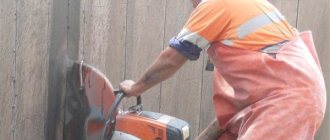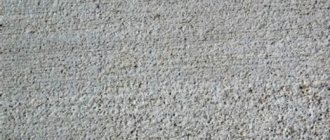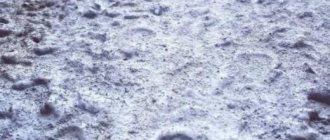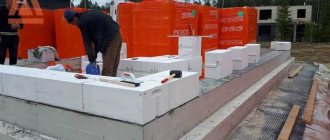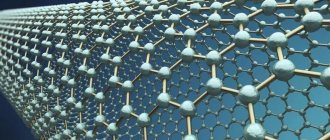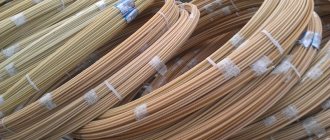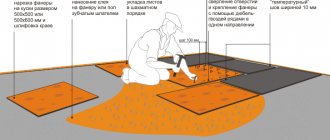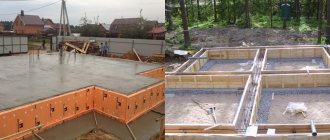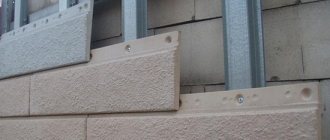Sulfur asphalt concrete
Sulfur concrete is a modern composite material, which is based on inert aggregates and fillers that perform the functions of a structural frame, and a binder—technical sulfur with modifying additives (see video in this article).
Sulfur, in its essence, is a thermoplastic. That is, composites made on the basis of this substance, including sulfur concrete, are thermoplastics.
General information
Structures made from such mixtures have high thermal insulation properties, strength, and are resistant to the chemical effects of acids, salts, oils, etc. If necessary, taking into account design requirements, the strength of products can be increased by introducing fiberglass into the solution (up to 7%). fiber.
Properties
Structure examples
Sulfur concrete has a number of positive qualities in comparison with other similar materials.
This:
- the period of strength development associated only with cooling of the mixture;
- low price of initial components;
- the possibility of recycling materials, which makes it possible to organize waste-free production of products;
- resistance to aggressive environments:
- the ability to harden mixtures at sufficiently low temperatures;
- due to the high setting speed - rapid mold turnover;
- low electrical and thermal conductivity;
- waterproof;
- increased frost resistance;
- high wear resistance.
Research results show that sulfur composites are significantly superior to classical cement mortars in terms of density, porosity and water permeability. For example, the water resistance of structures made from these materials is 10–20 times higher than that of similar products made from heavy concrete.
Another important factor is the wear resistance of coatings, which is almost five times higher than the values of products used with cement binders.
Comparative characteristics of materials
However, despite such positive characteristics, certain disadvantages of sulfur concrete can negatively affect its widespread use:
- High temperature (140°C) for preparing mixtures.
- High cost of installation for production of products (10–12 million).
- High toxicity of production (emission of hydrogen sulfide).
- Low heat resistance (+90°C).
Classification of sulfur concrete
Classification of concrete
Sulfur concrete in its composition belongs to the category of special concrete. General technical standards and requirements for mixtures and their products are listed in the preliminary national standard - PNST105-2016.
The conditions of this standard must be observed when designing and drawing up technological documentation, as well as being guided when carrying out construction work and determining the quality of finished structures.
Considering the average density, composites are divided into the following categories:
- especially heavy - density >2.8 g/cm3 (SbS O), grade D2500 and higher;
- heavy, with an average density of 1.8–2.8 g/cm3 (SbS T), D2000–D2500;
- lungs - <1.8 g/cm3 (SbS L), within D800-D2000.
According to workability indicators, they are divided into groups:
- hard (F);
- movable (P);
- cast (L).
The conventional name of a sulfur concrete mortar of standard quality consists of the abbreviation: mobility group, strength class, and, if necessary, frost resistance, average density and water resistance can be indicated.
Hints: for example, mobile sulfur concrete mixture (P) for the preparation of heavy concrete of strength class B25, with frost resistance value F 2200 and water resistance W 4 - designated: SbS T-P-B25 F2200 W4.
According to strength class they are divided into:
- durable B10—B60;
- high-strength - more than B60.
Physical and mechanical characteristics
Application
Sulfur concrete is used in structural elements of residential buildings and industrial structures, during the operation of which high values of weather and frost resistance, impermeability, and increased resistance to aggressive environments are required.
Sulfur concrete road slab
The most widespread use of sulfur concrete is in the production of the following small-piece products and structures:
- Construction of road surfaces (sulfur asphalt concrete).
- Production of prefabricated road pavement elements (slabs, side stones, end blocks, road barriers, paving slabs).
- Elements of buildings that are exposed to a salt environment during operation (foundations, floors, drainage trays, etc.).
- Engineering structures (sewer pipes, collector rings, wastewater treatment plants).
Method for producing sulfur cement
(51) 04 28/36 (2006.01) COMMITTEE ON INTELLECTUAL PROPERTY RIGHTS OF THE MINISTRY OF JUSTICE OF THE REPUBLIC OF KAZAKHSTAN (57) The invention relates to the field of industrial and civil construction carried out under conditions of exposure to aggressive environments, in particular, to the production of sulfur cement. A method for producing sulfur cement is proposed by grinding sulfur with a gossypol resin modifier and wollastonite filler in a ball mill in a wt. sulfur - 30, modifier - 20, filler 50, and grinding is carried out until the specific surface area is 1600-3000 cm 2/g. The proposed method for producing sulfur cement is simpler compared to the technology of the known method. The resulting sulfur cement can be used as a thermoplastic binder for various types of construction products of trays, borders, paving slabs, etc. (72) Imangaliev Telzhani Alzhapparova Merurta Tursinbaevna Almanov Gabit Abatovich Talgat Alekgamyikovyk Imansyan Telegliyanovyan Telezhanovo h Myrzakhmetova Botakoz Babitovna Dzhakipbekova Nagima Ormanbekovna (73) Republican state government enterprise South Kazakhstan State University named after. M. Auezova Ministry of Education and Science of the Republic of Kazakhstan (54) METHOD FOR PRODUCING SULFUR CEMENT The invention relates to the field of industrial and civil construction carried out under conditions of exposure to aggressive environments, in particular, to the production of sulfur cement. There is a known method for producing sulfur cement, in which a homogeneous solution of sulfur and modifier is treated with a rotating electromagnetic field of a vortex layer apparatus B 150 K-01 at a temperature of 140-150 C for 5-20 s. Ratio of solution components, wt. sulfur 90 - 98 modifier 2-10. As a modifier, an oil residue is used, for example, fuel oil, pre-treated with a rotating electromagnetic field at a temperature of 300-350 C for 10-60 s. (RF Patent 2154602, 08/20/2000). The disadvantage of this method is the pre-treatment of the modifier with a rotating electromagnetic field at a high temperature of 350 C. The closest to the proposed invention in technical essence and achieved result is a method for producing sulfur cement containing technical sulfur and finely ground mineral filler, basic ratio 11, degree of grinding 2000 cm 2/g . Quartz sand or stone flour is used as a filler. The basic grinding value of 2000 cm 2/g was taken based on the optimal, practically sufficient limit, because with further grinding, production efficiency decreases sharply, for example, when grinding up to 3000 cm 2 / g, the strength of the product increases by 10, and the productivity of the unit is reduced by half (RF Patent 2319674, 2008.03.20). The disadvantage of this method is the grinding of sulfur and mineral filler to a basic grinding value of 2000 cm 2 /g, which is difficult to control in a ball or vibration mill. The objective of the invention is to develop a method for producing sulfur cement while simplifying the process technology. The technical result is the simplification of the method for producing sulfur cement and the utilization of technical sulfur, which is formed during the oil and gas production process and is classified as industrial waste. Kazakhstan has accumulated about 18 million tons of technical sulfur. The problem is solved by the fact that in the method of producing sulfur cement, which consists in jointly grinding sulfur with a filler, according to the invention, a modifier is additionally introduced into the mixture - gossypol resin in the ratio, wt. sulfur - 30, modifier - 20, filler - 50. Moreover, grinding is carried out until a specific surface area of 16,003,000 cm 2 / g is reached. Wollastonite can be used as a filler. Gossypol resin is a waste product from the production of vegetable oils. Technical characteristics of gossypol resin according to OST 18-11473. Homogeneous, viscous mass of dark brown or black color 70-100 80 1.0 Acid number, in mg KOH Solubility in acetone, in Ash content in, not more than Moisture and volatile substances content in, not more than The method is carried out as follows through dispensers, loaded into a ball mill a certain amount of sulfur, filler and modifier is ground to a specific surface area in the range of 1,603,000 cm 2 /g. Example 1. 30 g of sulfur, 20 g of gossypol resin and 50 g of wollastonite are ground in a ball mill to a specific surface area of 1600 cm 2 /g. Basic sulfur cement is obtained. Strength within 60 MPa/cm 2. Example 2. 30 g of sulfur, 20 g of gossypol resin and 50 g of wollastonite are ground in a ball mill to a specific surface area of 2000 cm 2/g. Basic sulfur cement is obtained. Strength within 75 MPa/cm2. Example 3. 30 g of sulfur, 20 g of gossypol resin and 50 g of wollastonite are ground in a ball mill to a specific surface area of 3000 cm2/g. Basic sulfur cement is obtained. Strength within 80 MPa/cm 2. Thus, the sulfur cement obtained by the proposed method can be used as a thermoplastic binder for the production of various types of building products, trays, curbs, paving slabs, etc. FORMULA OF THE INVENTION A method for producing sulfur cement, which consists of a joint grinding a mixture of technical sulfur with a mineral filler, characterized in that a modifier is additionally introduced into the mixture - gossypol resin, with the following ratio of components, wt. sulfur 30, modifier - 20, filler - 50, and grinding is carried out until a specific surface area of 16,003,000 cm 2 / g is reached.
Materials for the production of sulfur concrete
The technology for manufacturing sulfur concrete is based on the fact that instead of water and Portland cement, technical sulfur (20–40%) or sulfur-containing industrial waste is used as a binding component to prepare mixtures.
Fillers
The role of coarse aggregate for heavy concrete is artificial or natural crushed stone of a porous or dense structure. The maximum grain size should not exceed 40 mm.
Natural crushed stone
For particularly heavy mixtures, it is necessary to use metal shavings or lead shot.
In the production of lightweight concrete, porous aggregates are used (GOST 32496-2013):
- expanded clay gravel;
- agloporite crushed stone;
- shungizite gravel;
- metallurgical slags.
Expanded clay gravel
Natural quartz sand is used as fine-grained aggregates, which in its composition can be:
- natural enriched;
- natural fractionated;
- crushed;
- crushed fractionated.
Fractionated quartz sand
Various types of fine and coarse aggregates are used, depending on the type and purpose of the structural elements being manufactured and the conditions of their use.
Fly ash
The role of inert fillers (see table), serving as structure formers, are finely dispersed materials with a grain size of less than 0.15 mm, including:
- andesite flour;
- marshalit;
- quartz flour;
- diabase flour;
- graphite powder;
- fly ash and other mineral powders.
Technical characteristics of some fillers
A separate line in the list of aggregates contains materials for reinforcing sulfur concrete - fibers. As a result of this approach to the production of products, strong and durable structures made of fiber-silver concrete are obtained.
Organic or inorganic fiber is used as fibers in an amount of 5–7% of the total volume of sulfur used:
- glass;
- polypropylene;
- polyester, etc.
Dispersed reinforcement is made with fibrous material in the form of threads tied into a bundle, pre-impregnated with an adhesive composition, for example, acrylic, epoxy or polyurethane resin. It is recommended to use fibers no longer than 3–5 cm with a fiber diameter of 150–350 microns.
Knitting
Sulfur within the temperature range of 15-20°C is a solid crystalline substance. It has low thermal and electrical conductivity, and is also insoluble in water.
Granular sulfur concentrate
This substance is capable of forming compounds with almost all organic and inorganic chemical elements. The melting point of the material is 120°C. And if you bring the temperature of molten sulfur to 445°C, it boils.
In addition to technical sulfur, sulfur-containing waste from various industrial processes is used to prepare sulfur concrete:
- waste from settling tanks, filters from chemical production (up to 70%);
- sulfur residues in smelting units (40%);
- sulfur ore enrichment waste (7%).
In the solid phase, sulfur is a brittle material in its qualities. As a result, the solidified melt does not have satisfactory strength.
Therefore, to obtain high-quality compositions based on sulfur binders, only modified substances are used that have an amorphous-crystalline structure, which significantly increases the mechanical properties of products.
Modified sulfur
Methods for modifying sulfur can be divided into three types:
- physical - adding structure-forming fillers to the composition;
- temperature - phase changes in sulfur depending on the increase or decrease in temperature;
- chemical method - introducing stabilizers and plasticizers into the melt.
The most common method of modifying sulfur is the use of special chemical additives, which make it possible to regulate both the properties of liquid mixtures and the characteristics of solid materials over a wide range.
Modifiers
Modifying additives are introduced at the time of preparation of the sulfur melt, depending on the operational requirements and the adopted production technology. The amount of a particular additive can be 1–10% of the total volume of sulfur concentrate.
According to their functional purpose, ligatures can be divided into several categories:
- plasticizers (rubber, styrene, petroleum polymer resins, paraffin, etc.);
Petroleum resins
- stabilizers (polyvinyl chloride, zinc chloride, etc.);
Zinc chloride
- flame retardants (arsenic sulfide, phosphorus trichloride);
Arsenic sulfide
- antiseptics (naphthalene, thymol).
Naphthalene
Hints: modification of sulfur compounds leads to higher costs and more complex processes for preparing solutions. Therefore, the use of additives must be justified both technically and economically.
The composition, modified by special additives, received the name: polymer sulfur.
SULFUR CONCRETE TACTILE PLATES
A pressing and important problem is the possibility of safe and comfortable movement of visually impaired people. Taking into account the fact that almost 9% of the population of Tatarstan are citizens with disabilities, of which 2.9 percent are blind and visually impaired (9.5 thousand people), one of the directions of the socio-economic development strategy of the Republic of Tatarstan is rehabilitation and social integration of disabled people. The most optimal material for tactile slabs is concrete. In Kazan in 2012, concrete tactile slabs were laid after a year of operation, 5 square meters. km laid on 52 streets require repair. Unfortunately, concrete tactile slabs based on Portland cement did not meet their performance characteristics, falling into disrepair en masse. As a rule, existing tactile plates have the following disadvantages: low strength, low crack resistance, low frost resistance and low chemical resistance. The solution to this problem is to increase the strength of concrete tactile slabs and their resistance to external environmental influences by replacing the binder, modifying the composition with additives and introducing reinforcing fibers. As an option, it was proposed to manufacture tactile slabs from sulfur concrete with the addition of basalt fiber. The production process of sulfur concrete samples includes the following steps:
– Preparation of raw materials
– Preparation of sulfur concrete mixture
– Forming samples
Samples of the sulfur binder were prepared as follows.
Sifted carbonate rock through a 0.16 sieve (Figure 3.1) weighing 120 grams was mixed with different weights of fiber (Figure 3.2). After thorough mixing, the sulfur melt was heated in a drying oven to a temperature of 155°C for 2 hours, at which it has a minimum viscosity, and while stirring, it was added in small portions to the carbonate filler.
After dissolving the sulfur until the melt was homogeneous, dolomitized limestone and basalt fiber, heated to the same temperature as the melt, were added to it, ground (to a specific surface of 3000 cm2/g). The resulting mass was filled with 2x2x2 cm cube molds preheated to a temperature of 150-160°C (Figure 3.3), the molds were placed in ovens and heated to a temperature of 175-185°C, after which the mass in the molds was kept at this temperature for 15-30 minutes at normal atmospheric pressure, the molds were removed from the dryer and cooled under normal conditions (room temperature). As a result, samples of sulfur binder with higher compressive strength were obtained, which were tested on a hydraulic press.
To select the optimal composition, 6 compositions with different contents of components were mixed. A distinctive feature of each composition is a change in the dosage of basalt fiber, which leads to a change in the dosage of the binder with the same mobility of the mixture.
Table 1.
Compositions of sulfur concrete binder
| Name | Dosage of components, kg/m3 | |||||
| Composition no. | 1 | 2 | 3 | 4 | 5 | 6 |
| Sulfur | 65 | 68 | 98 | 147 | 93 | 69 |
| Filler | 120 | 120 | 120 | 120 | 120 | 120 |
| Fiber | — | 0,36 | 0,48 | 0,6 | 1,2 | 3,6 |
| Sum | 185 | 188,36 | 218,48 | 267,6 | 214,2 | 192,6 |
The prepared binder mass was molded into molds 2x2x2 cm. The compressive strength was tested on a hydraulic press after curing for a day under natural storage conditions. The tests were carried out 2 times to ensure the correctness of the results shown. The test results are presented in table. 2
Table 2.
Strength indicators of sulfur concrete
| №№ Composition | Fiber dosage, kg/ | Compressive strength, kN | ||
| 1 test | 2 test | |||
| 1 | — | 860 | 840 | |
| 2 | 0,36 | 640 | 620 | |
| 3 | 0,48 | 940 | 980 | |
| 4 | 0,6 | 1480 | 1600 | |
| 5 | 1,2 | 860 | 910 | |
| 6 | 3,6 | 1240 | 1100 | |
According to the results obtained, sulfur concrete using basalt fiber fibers showed high strength characteristics, which indicates the feasibility of replacing concrete tactile tiles based on Portland cement with tactile slabs based on sulfur concrete. The process of producing sulfur concrete is based on the property of sulfur to change its viscosity at different temperatures - at 119–122 ° C, sulfur completely transforms from the crystalline state into a melt. Acid-resistant cement, andesite or quartz flour, quartz sand and other acid-resistant mineral fillers are used as fillers. In many countries, sulfur concrete is used for the manufacture of piles, foundations, tanks, road surfaces and chemical-resistant floors. One of the factors hindering the widespread introduction of sulfur concrete in our country is its cost, which is approximately 2 times higher than Portland cement concrete. However, there are many chemical enterprises that have sulfur-containing waste that contains from 25 to 80% technical sulfur. Also, the amount of sulfur-containing waste is generated during sulfur mining.
Bibliography:
- Promising directions for processing sulfur and sulfur-containing products. //Materials of the scientific and technical council at OJSC Tatneftekhiminvest-holding. Kazan, May 13, 2002
- Physico-chemical properties of sulfur / Review information /.- M.: NIITEKHIM, 1985. –35 p.
- Busev A.I., Simonova N. Analytical chemistry of sulfur. – M.: Nauka, 1975.–271 p.
- Orlovsky Yu.I., Ivashkevich B.P., Yuryeva E.V. Biocorrosion of sulfur concrete // Concrete and reinforced concrete. - 1989. -No. 4.- P.45-46.
- Akhverdov I.N. Fundamentals of concrete physics. – M.: Stroyizdat, 1981. – 464 p.
- Remi G. Course in inorganic chemistry. – M.: Foreign Literature Publishing House, 1963. – T.1. – 920 s.
- Chemical technology of inorganic substances / Akhmetov T.G., Busygin V.M., Gaisin L.G. and others – M.: Chemistry, 1998. – 448 p.
- Reactions of sulfur with organic compounds / Ed. Voronkova. A.I. -Novosibirsk: Nauka, 1979. - 368 p.
- Menkovsky M.A., Yavorsky V.T. Sulfur technology. – M.: Chemistry, 1985. – 286 p.
- Popular library of chemical elements // Science and technology. Electronic version. – 2002. [http: www.phys.web.ru]
- Chemical encyclopedia: T.4. – M.: Great Russian Encyclopedia, 1995.-635 p.
- Korolev E.V., Proshin A.P., Solomatov V.I. Sulfur composite materials for radiation protection. - Penza: PGASA, 2001 – 208 p.
